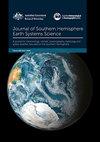Case study on the use of dynamically downscaled climate model data for assessing water security in the Lower Hunter region of the eastern seaboard of Australia
IF 3.6
4区 地球科学
Q1 Earth and Planetary Sciences
引用次数: 0
Abstract
A key aim of the Eastern Seaboard Climate Change Initiative (ESCCI) is under-standing the effect of climate change on the eastern seaboard of Australia, and the implications for climate change adaptation in this area. The New South Wales (NSW) / Australian Capital Territory (ACT) Regional Climate Modelling project (NARCliM) has produced three dynamically downscaled reanalysis climate datasets along with 12 downscaled general circulation model (GCM) projections of current (1990–2009) and future climate. It is expected that the NARCliM dataset will be used for many climate change impact studies including water security assessment. Therefore, in this study we perform a case study investigation into the usefulness and limitations of using NARCliM data for water security assessment, using the Lower Hunter urban water supply system managed by Hunter Water Corporation. We compare streamflow and reservoir levels simulated using NARCliM rainfall and a gridded historical rainfall dataset (AWAP) and focus our analysis on the differences in the simulated streamflow and reservoir levels. We show that when raw (i.e. not bias-corrected) NARCliM rainfall and potential evapotranspiration (PET) data is used to simulate streamflow and reservoir storage levels, some of the NARCliM datasets produce unrealistic results when compared with the simulations using AWAP; for example, some NARCliM datasets simulate reservoirs at or near empty while the AWAP reservoir simulations rarely drop below 60%. The bias-corrected NARCliM rainfall (corrected to AWAP) produces estimates of streamflow and reservoir levels that have a closer, but still inconsistent, match with the streamflow and reservoir levels simulated using AWAP directly. The inconsistency between the simulations using bias-corrected rainfall and historical AWAP rainfall is potentially because while bias-correction reduces systematic deviations it does not fix temporal rainfall sequencing issues. Additionally, the NARCliM PET is not bias-corrected and using bias-corrected rainfall with uncorrected PET in hydrological models results in physical inconsistencies in the rainfall-PET relationship and simulated streamflow. We demonstrate that rainfall plays a large role in the streamflow simulations, while PET seems to play a large role in the reasonableness of the simulated reservoir dynamics by determining the evaporation losses from the reservoirs. The downscaled GCM datasets that simulate the greatest average PET for 1990–2009 show reservoirs often (unrealistically) near empty. This study highlights the need to assess the validity of all climate data for the applications required, with a focus on long-term statistics for reservoir modelling and ensuring realism and coherence across all projected variables.动态缩小尺度气候模式数据用于评估澳大利亚东海岸下亨特地区水安全的案例研究
东海岸气候变化倡议(ESCCI)的一个主要目标是了解气候变化对澳大利亚东海岸的影响,以及对该地区适应气候变化的影响。新南威尔士州(NSW) /澳大利亚首都地区(ACT)区域气候模拟项目(NARCliM)产生了三个动态缩小尺度的再分析气候数据集,以及12个缩小尺度的环流模式(GCM)对当前(1990-2009)和未来气候的预测。预计NARCliM数据集将用于包括水安全评估在内的许多气候变化影响研究。因此,在本研究中,我们以Hunter water Corporation管理的Lower Hunter城市供水系统为例,对使用NARCliM数据进行水安全评估的有效性和局限性进行了案例研究。我们比较了使用NARCliM降雨和网格化历史降雨数据集(AWAP)模拟的河流流量和水库水位,并重点分析了模拟的河流流量和水库水位的差异。研究表明,当使用原始(即未经偏差校正的)NARCliM降雨和潜在蒸散(PET)数据来模拟河流和水库蓄水量时,与使用AWAP模拟相比,一些NARCliM数据集产生的结果不现实;例如,一些NARCliM数据集模拟的储层处于或接近空区,而AWAP储层模拟很少低于60%。经过偏差校正的NARCliM降雨量(校正为AWAP)产生的河流流量和水库水位估算值与直接使用AWAP模拟的河流流量和水库水位更接近,但仍然不一致。使用偏差校正降雨量的模拟与历史AWAP降雨量之间的不一致可能是因为虽然偏差校正减少了系统偏差,但它并没有解决时间降雨顺序问题。此外,NARCliM PET没有进行偏差校正,在水文模型中使用偏差校正的降雨量和未校正的PET会导致降雨量-PET关系和模拟水流的物理不一致。研究表明,降雨在径流模拟中起着重要作用,而PET通过确定水库的蒸发损失,似乎在模拟水库动力学的合理性中起着重要作用。缩小后的GCM数据集模拟了1990-2009年的最大平均PET,显示水库通常(不切实际地)接近于空。这项研究强调了评估所有气候数据有效性的必要性,重点是水库建模的长期统计数据,并确保所有预测变量的真实性和一致性。
本文章由计算机程序翻译,如有差异,请以英文原文为准。
求助全文
约1分钟内获得全文
求助全文
来源期刊

Journal of Southern Hemisphere Earth Systems Science
Earth and Planetary Sciences-Oceanography
CiteScore
8.10
自引率
8.30%
发文量
0
审稿时长
>12 weeks
期刊介绍:
The Journal of Southern Hemisphere Earth Systems Science (JSHESS) publishes broad areas of research with a distinct emphasis on the Southern Hemisphere. The scope of the Journal encompasses the study of the mean state, variability and change of the atmosphere, oceans, and land surface, including the cryosphere, from hemispheric to regional scales.
general circulation of the atmosphere and oceans,
climate change and variability ,
climate impacts,
climate modelling ,
past change in the climate system including palaeoclimate variability,
atmospheric dynamics,
synoptic meteorology,
mesoscale meteorology and severe weather,
tropical meteorology,
observation systems,
remote sensing of atmospheric, oceanic and land surface processes,
weather, climate and ocean prediction,
atmospheric and oceanic composition and chemistry,
physical oceanography,
air‐sea interactions,
coastal zone processes,
hydrology,
cryosphere‐atmosphere interactions,
land surface‐atmosphere interactions,
space weather, including impacts and mitigation on technology,
ionospheric, magnetospheric, auroral and space physics,
data assimilation applied to the above subject areas .
Authors are encouraged to contact the Editor for specific advice on whether the subject matter of a proposed submission is appropriate for the Journal of Southern Hemisphere Earth Systems Science.
 求助内容:
求助内容: 应助结果提醒方式:
应助结果提醒方式:


